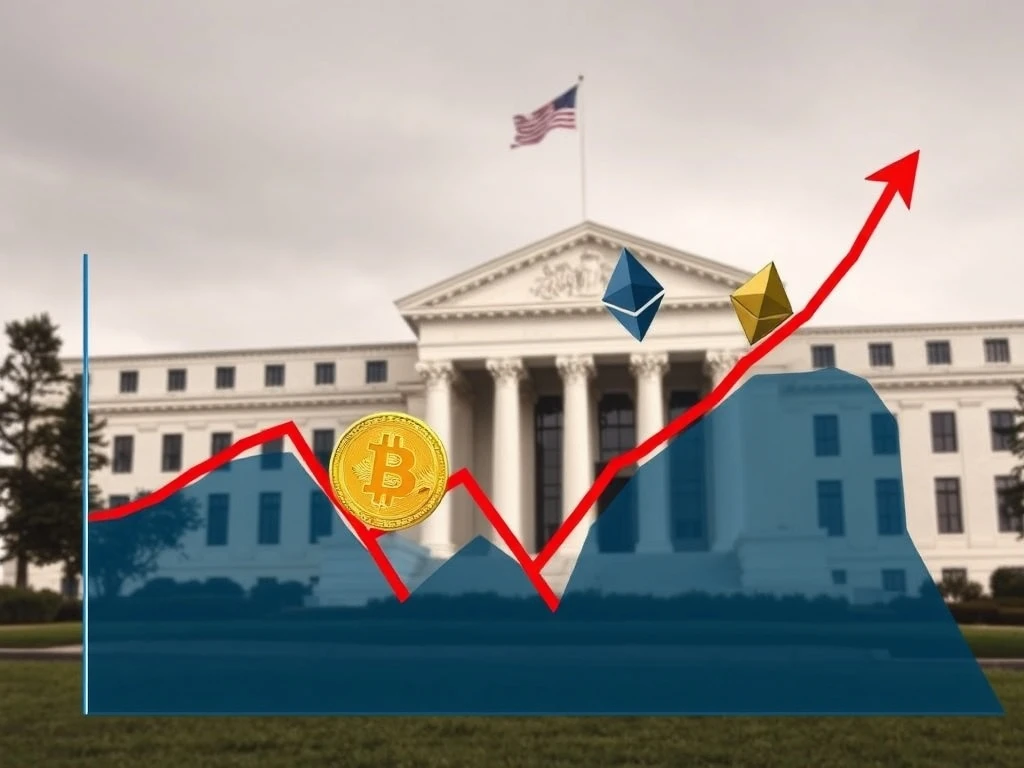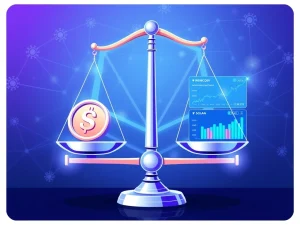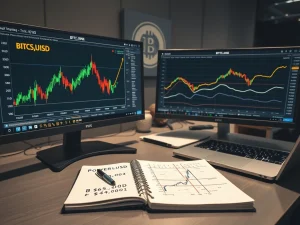Fed Rate Cut: Crucial Catalyst for a Bullish Crypto Market Surge Amidst Federal Reserve Shakeup

The cryptocurrency world holds its breath, keenly anticipating a significant shift from the US Federal Reserve. Investors and traders alike are preparing for an expected **Fed rate cut** this week. This pivotal decision could unlock substantial liquidity and dramatically reshape the current **crypto market outlook**. Such a move traditionally signals a bullish phase for digital assets, attracting capital from more conservative investments. However, this monetary policy adjustment unfolds against a backdrop of unprecedented political turbulence within the central bank itself, raising questions about the future independence of the **Federal Reserve policy** and its long-term implications for the digital asset space.
Fed Rate Cut Anticipation: A Bullish Signal for Crypto
As Wednesday approaches, all eyes remain fixed on the US Federal Reserve. Analysts widely expect the central bank to announce a **Fed rate cut**. This move is a powerful signal for financial markets globally. Historically, lower interest rates on traditional assets, such as bonds, reduce their attractiveness. Consequently, investors often seek higher returns in riskier, yet potentially more rewarding, assets. Cryptocurrencies, known for their volatility and growth potential, fit this profile perfectly.
The mechanism is straightforward: when borrowing costs decrease, capital becomes cheaper. Businesses can expand more readily, and individuals have more disposable income. Furthermore, lower yields on government bonds mean that the opportunity cost of holding riskier assets like Bitcoin or Ether diminishes. This encourages a shift of funds into the crypto ecosystem, potentially fueling significant rallies. Many market participants are positioning themselves for this anticipated influx of liquidity.
Kevin Rusher, founder of real-world asset (RWA) borrowing and lending ecosystem RAAC, shared his insights with Crypto News Insights. He noted that “markets are on edge” in anticipation. Rusher further predicted that resuming the cutting cycle would “unlock the $7.2 trillion sitting in money market funds, as well as the trillions tied up in outstanding mortgage debt.” This vast pool of capital could flow into alternative yield-generating investments. Decentralized finance (DeFi) and real-world assets (RWAs) are prime candidates to benefit from this renewed liquidity. Ultimately, a **Fed rate cut** injects optimism into the broader financial landscape, directly benefiting speculative assets.
Federal Reserve Policy Under Scrutiny: Political Tensions Rise
Beyond the immediate rate decision, a significant political shake-up is unfolding within the Federal Reserve itself. This internal struggle could profoundly influence future **Federal Reserve policy**. US President Donald Trump’s administration has initiated efforts to remove Fed governor Lisa Cook, a Biden-era appointee. On August 25, the White House X page posted a letter from Trump, accusing Cook of making false statements on mortgage agreements. Cook, however, denied these accusations, refusing to step down. Her legal team asserted that the charges were politically motivated. They described the White House’s actions as “scrambling to invent new justifications for its overreach.” Cook herself called the attempt “unprecedented and illegal.”
On Monday, an appeals court in Washington temporarily blocked the White House from removing Cook. This ruling allows her to maintain her position while the legal case proceeds. Simultaneously, the Senate confirmed Stephen Miran, a White House economic adviser, to the board of governors. Miran, an economist and chairman of the Council of Economic Advisors, has previously expressed pro-crypto views. His term is temporary, ending in January 2026. However, Miran has not committed to stepping down as a White House adviser should his term extend beyond January 31. This situation has raised concerns among Democratic legislators. They worry that the Fed’s monetary policy agenda could become more beholden to Trump’s political objectives. Such a development challenges the long-standing principle of Fed independence.

Bitcoin price spiked in 2021-2022 amid low US interest rates. Source: Trading Economics
Implications of a Politicized Federal Reserve for Crypto
A less independent Federal Reserve presents uncharted territory for **US monetary policy** and, by extension, the crypto industry. The central bank wields immense authority over commercial banks. These banks, in turn, act as quasi-regulators for crypto. They determine which crypto businesses can access essential financial services. Aaron Brogan, founder of the crypto-focused law firm Brogan Law, emphasized this point to Crypto News Insights. He stated, “The Fed has great authority over banks, and ultimately, banks are quasi-regulators of the crypto industry by determining who can and cannot access financial services.”
Brogan further suggested that this influence is unlikely to diminish. However, the policy itself might become more fluid. “I would wager it would be more changeable and susceptible to public whims,” he predicted. The potential for policy shifts creates uncertainty for an industry already grappling with regulatory ambiguities. When asked about the implications of a less independent Fed for **US monetary policy**, Brogan admitted, “Nobody knows.” He speculated on the common assumption that a dependent Fed might adopt more liberal, profligate monetary policies due to increased responsiveness to public opinion. Yet, he concluded, “Since we haven’t seen it, it is pure speculation. In this administration, at least, Trump would cut rates.” This political intervention introduces a new layer of complexity to an already dynamic market.

Trump sought to remove Cook on Aug. 25 “effective immediately.” Source: Rapid Response 47
Understanding the Bitcoin Price Impact of Rate Adjustments
The anticipated **Fed rate cut** carries significant weight for the **Bitcoin price impact**. Bitcoin, as the leading cryptocurrency, often serves as a bellwether for the broader digital asset market. Historical data strongly supports the idea that lower interest rates correlate with higher Bitcoin valuations. For example, Bitcoin’s price experienced a notable spike during 2021-2022. This period coincided with historically low US interest rates. When the cost of capital is cheap, investors are more inclined to allocate funds to high-growth, speculative assets like Bitcoin.
The Kobeissi Letter, a respected financial publication, provided compelling insights into this phenomenon. They observed that when the Fed cuts rates within 2% of all-time highs, the S&P 500 typically performs well. While immediate-term results might vary, “in 20 of the last 20 times this has happened, the S&P 500 has ended higher 1 year later.” This historical trend suggests a strong positive correlation between rate cuts and asset appreciation. The Kobeissi Letter expects a similar outcome this time, predicting “more immediate-term volatility, but long-term asset owners will party.”
Furthermore, they highlighted the proactive behavior of certain assets. “Gold and Bitcoin have known this,” The Kobeissi Letter wrote. “The straight-line higher price action we have seen in these asset classes is pricing-in what’s coming. Gold and Bitcoin know lower rates into an already HOT backdrop will only push assets higher. It’s a great time to own long-term assets.” This perspective underscores Bitcoin’s role as a potential hedge against traditional financial volatility and its sensitivity to shifts in monetary policy. Consequently, a **Fed rate cut** is widely viewed as a significant tailwind for Bitcoin’s valuation.
Broader Crypto Market Outlook: Beyond Bitcoin
While Bitcoin often captures headlines, the broader **crypto market outlook** also reacts strongly to interest rate changes. Alice Liu, research lead at CoinMarketCap, explained to Crypto News Insights that “high-beta layer 1s” are particularly sensitive. These include prominent networks like Ether (ETH) and Solana (SOL). She noted, “These trade like growth tech — more sensitive to liquidity and risk appetite than BTC.” Therefore, as interest rate cuts potentially trigger additional capital injections into risk-on assets, investors may increasingly deploy funds into ETH’s “digital oil” narrative or SOL’s adoption growth story.
Beyond layer 1 blockchains, decentralized finance (DeFi) tokens are also poised for growth. Liu commented that DeFi tokens become “relatively more attractive” when interest rates fall. This boosts tokens tied to lending and decentralized exchange (DEX) activity. The flow of capital into DeFi protocols creates a virtuous cycle. It increases liquidity, lowers borrowing costs within DeFi, and enhances overall ecosystem activity. Similarly, real-world asset (RWA) tokens, which bridge traditional assets with blockchain technology, could see increased adoption. These assets offer new yield opportunities that become more appealing in a low-interest-rate environment. Ultimately, the **Fed rate cut** is expected to stimulate activity across diverse sectors of the crypto market.
Navigating Future US Monetary Policy and Crypto Growth
The ongoing political battle for control over the Federal Reserve remains undecided. Regardless of who ultimately pulls the levers, the impending **Fed rate cut** represents a welcome development for crypto traders and long-term investors alike. The potential for increased liquidity and a renewed appetite for risk assets paints a generally optimistic **crypto market outlook**. This period highlights the intricate connection between traditional financial systems and the burgeoning digital asset space. Understanding these macroeconomic shifts is crucial for navigating the evolving landscape.
The intersection of **US monetary policy** and crypto development is becoming increasingly apparent. A less independent Fed, while introducing new variables, may still lean towards policies that favor asset inflation, as suggested by experts. This scenario could further bolster the appeal of digital assets. Investors are closely monitoring these developments, positioning themselves to capitalize on the anticipated market movements. Ultimately, the next few months will reveal how these intertwined forces shape the future trajectory of the crypto economy.

Bitcoin and gold soar after interest rate cuts. Source: Kobeissi Letter









